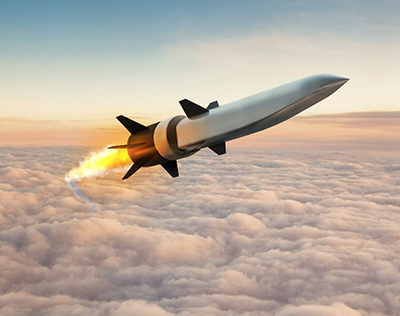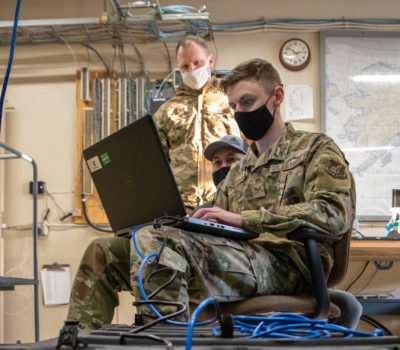Air Force Set to Get Rid of Small A-29, AT-6 Fleets, Program Official Says
F-35 Squadrons in Alaska Shift to Full Operations as ‘Advanced Threats’ Grow ‘More Lethal’
Richardson: TBG and HAWC Can Still ‘Inform’ Other Hypersonic Efforts
Air Force Was ‘Hyper Focused’ on Cybersecurity for IT Networks. Now Other Systems Need Protection.
Biden Signs PACT Act to Expand VA Coverage for Toxic Exposure, but Some Are Left Out
Radar Sweep
U.S. Space Command Basing Decision Approaching Final Stretch
The head of U.S. Space Command said he expects a final decision to be made relatively soon on where the command will be permanently headquartered. The Department of the Air Force in January 2021 recommended that Space Command, currently located at Peterson Space Force Base, Colo., move to Redstone Arsenal in Huntsville, Ala. The basing decision has since been embroiled in a political fight as Colorado lawmakers have pushed back. Space Command is responsible for providing satellite-based services to the U.S. military and for protecting those assets from foreign threats.
GAO: Military Academies' Efforts to Measure Diversity Are Incomplete
The Government Accountability Office is raising questions about the Defense Department’s military academies. In a new report, the GAO says the schools have taken actions to improve organizational climate by incorporating leading practices for managing workforce diversity. Additionally, the GAO says the service academies have recognized the need to recruit more diverse faculty, but need to develop measures to assess the success of their actions.
This Air Force Drone Just Proved It Can Be a ‘Grunt Angel’ in a War With China
Sometimes it’s not the weapons that win battles, but the tools troops use to see, hear, and communicate about what’s going on. That seems to ring true, as the Air Force risked sending a multi-million dollar aircraft over 9,000 miles of open ocean to prove it could serve both as a persistent source of targeting and sensor information and also relay that information to service members throughout the Pacific in a possible war against China.
SPACECOM Integrating Army, Navy Sensors to Improve Space Monitoring
U.S. Space Command is now integrating “non-traditional” sensors, originally built for tracking and targeting ballistic missiles, into its network for keeping tabs on satellites and spacecraft, said Gen. James H. Dickinson, SPACECOM commander. Those sensors “now provide increased fidelity to the understanding of the space environment,” he told the Space and Missile Defense Symposium in Huntsville, Ala.
COMMENTARY: Campaigning at the Top of the World: The Arctic and Homeland Defense
“The 2022 National Defense Strategy outlines defending the homeland as priority No. 1. To ensure homeland defense, North American Aerospace Defense Command and U.S. Northern Command require credible capability to deter strategic competitor actions across the whole of our area of operations and responsibility, including the Arctic. While some may challenge the importance of the Arctic to U.S. national security, Russia and the People’s Republic of China have clearly made long-term Arctic investments,” writes Gen. Glen D. VanHerck, commander of North American Aerospace Defense Command and U.S. Northern Command.
Top U.S. Generals Take Issue With Russian Satellite Near U.S. Orbit
In an NBC News exclusive, the first-ever cameras were allowed inside U.S. Space Command, where the military tracks every rocket and missile launch around the globe. SpaceX has launched what is believed to be a top secret, state-of-the-art spy satellite that will support the Pentagon’s “overhead reconnaissance mission.” Meanwhile, U.S. commanding generals are concerned about a new spy satellite that Russia just put into orbit.
Questions Surrounding System-of-System Network Technologies 'Permeate' Department of Air Force Operational Imperatives
When Timothy Grayson, special assistant to the secretary of the Air Force for mission-centered analysis and operational imperatives, considers how to best master and facilitate “system-of-systems” network technologies, he cautions that there is a ceiling to the intricacies people and organizations can grasp. “I don’t care if it’s human beings or computers. There’s a limit to how much complexity we can manage … So, we need to figure out a way to isolate and manage the complexity of the decision space while still being able to access as much of the optionality as possible,” Grayson reasoned.
A Year Later, Afghan Refugees Remain in Legal Limbo as Vets Continue Evacuating Allies Left Behind
Thousands of Afghans brought to the United States during the American military evacuation after the Taliban overran Kabul remain in a legal limbo nearly a year later, unsure whether they will be able to remain in their new country when their temporary immigration status expires soon. Meanwhile, as the one-year anniversary of the withdrawal approaches, veterans groups have not let up efforts to get out the estimated 78,000 Afghans who aided the 20-year effort but were left behind when the last U.S. troops departed.
Air Force Builds on Incremental ABMS Improvements, Ready to Expand Program
This spring, the Air Force brought in lawmakers to witness the latest developments of its Advanced Battle Management System. The tour included the Shadow Operations Center-Nellis, a laboratory that is identifying emerging technologies for faster data transfer to service members. “The Shadow Operations Center is critical to the Air Force’s drive to link information to sensors and shooters in real time,” Air Force Chief of Staff Gen. Charles Q. Brown Jr. said. “As our service continues to accelerate change, the revelations coming out of this battle lab will help our warfighters more quickly understand, share, decide, and act, which will provide them a greater advantage on the battlefield.”
Canada Plans to Buy 4 New Airbus Tankers, Requests Proposal
The Canadian government expects to award a contract to Airbus in 2023 for four new strategic tanker transport aircraft, according to the country’s National Defence Department. The Canadian Armed Forces found that the Airbus A330 MRTT, a refueling and transport plane, is the only aircraft qualified for the job. The Air Force wants the first of the A330s operational by 2028.
What Happened to the B-25s of ‘Catch-22’?
Eighteen B-25s flew for “Catch-22.” One was deliberately destroyed during the production. Here’s what happened to all these supporting actors.






